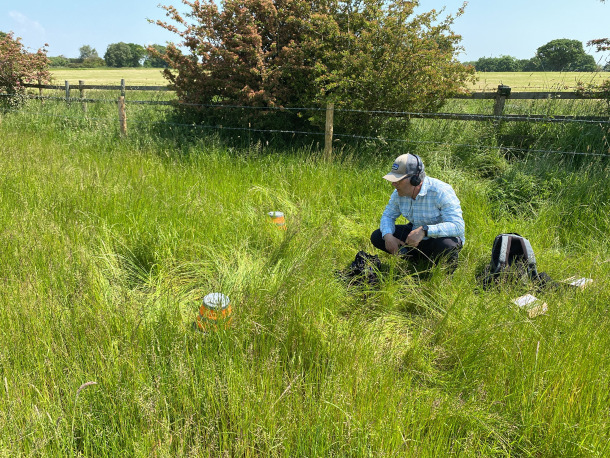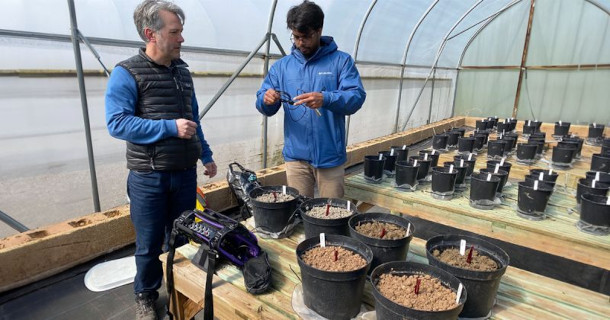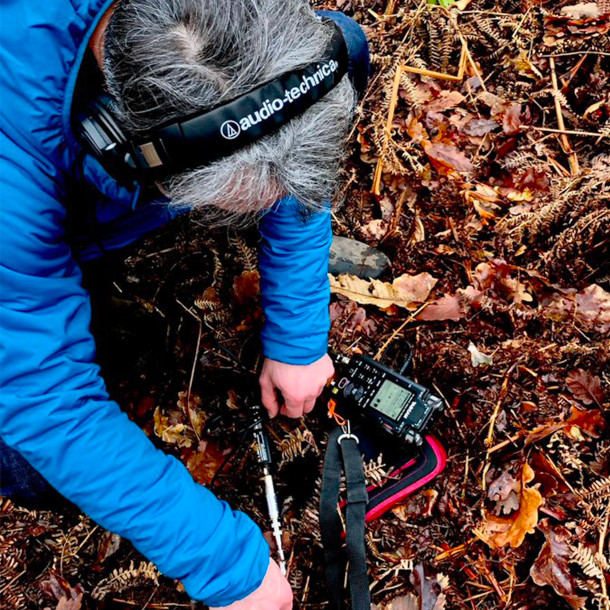Sounds of Soil
Air Date: Week of May 24, 2024

Listening to sounds in the soil is a minimally invasive way to measure biodiversity underground. (Photo: Courtesy of Baker Consultants Ltd.)
Sounds like the overlapping songs of birds can speak volumes about the biodiversity in an ecosystem, and now scientists are looking to use the tiny sounds made by earthworms, ants, and voles to study the health of soils. Ecologist Carlos Abrahams joins Host Aynsley O’Neill to explain why more varied sounds appear to indicate healthier soils, and the potential applications of listening for these sounds in the earth.
Transcript
O’NEILL: When you step outside on a warm sunny day, you might hear birds chirping, squirrels chittering, or even the telltale rattle of a snake. But ecologist Carlos Abrahams spends his days with an ear to the ground. Carlos specializes in ecoacoustics, the study of sound in the environment. And his recent work focuses on finding a way to link the sounds of the dirt under our feet to soil health. Healthy soil needs biodiversity, so his work listens for slithering earthworms.
[EARTHWORM SFX]
O’NEILL: Marching ants.
[ANTS SFX]
O’NEILL: And tunneling voles.
[VOLE SFX]
O’NEILL: With the idea that these signs of life can tell us just how well the soil’s doing. Carlos Abrahams joins us now for more. Welcome to Living on Earth, Carlos!
ABRAHAMS: Thanks for having me. Great to be here.
O'NEILL: So Carlos, what do we know about the link between soil sounds and soil health?

Dr. Abrahams’ research aims to use soil acoustics to help sustainable agriculture measure improvements in soil health. (Photo: Courtesy of Baker Consultants Ltd.)
ABRAHAMS: So we think those two things are linked together. And we know that in other environments aboveground, we get good links between the sounds that are produced in an ecosystem and species diversity, species richness. That's been shown in various places around the world. So taking that learning from aboveground, we're hoping to apply the same sort of principles to the sounds from soil as well. And it does seem to be, from the initial work that ourselves and other people have done, that where you have diverse sounds, that is a good indicator of good environmental health, good land management practice, and lots of fauna in the soil, so a biodiverse soil fauna. Where we have poor sounds within the soil and they aren't complex, and there's not much going on, then that's often an indicator, for example, of bare soil, or one that's been highly agriculturally improved, and had lots of chemicals put into it potentially. So the work that we've done and other people have done have sort of given us a good nod in the right direction that if we take sounds from the soil and analyze those, they will be a good indicator for soil health, soil biodiversity.
O'NEILL: And so once you have this recording, how do you learn from it? How do you figure out what that says about the soil?
ABRAHAMS: Okay, so these days, we have two main ways to take sounds from the environment and use those to study wildlife ecology. And one way is to try and recognize the individual voices of different birds or different bats or different sorts of soil fauna, whether that's earthworms or beetles. And aboveground, there's been lots of development of that. So some of the universities in the States have done superb work in terms of building recognizers that the you can now take a recording, hit it with their fantastic AI algorithms, and it will tell you what bird species it is. And we have similar recognizers that do that for bats as well. And we can do that pretty well for a whole range of different species underwater as well. The unfortunate thing is that we don't have enough recordings from known species within the soil at the moment to build up a library and a classifier to allow us to know what is making what sound. One of the big parts of the projects we're currently doing for the UK government at the moment with this grant scheme is to try and do that. So we have buckets of different sorts of worms, and we're trying to record one type of worm versus another worm versus woodlice versus centipedes, whatever it might be. So that's the first approach. The other approach that’s become available in the last 10 years or so is not to try and identify species, but to use an acoustic index that allows you to take a recording and analyze how complex the sound is within that recording. So we can take a one-minute sound file, and if there's lots of different things going on, there's lots of sound being produced, then we can give that a number. We're hoping that we can link that to good soil health or good land management practice. And if those sounds are very quiet, there's not much going on, then we know that there's not much fauna activity within the soil. And that's possibly, probably going to be related to poor soil health.

In addition to collecting audio from natural and agricultural environments, Abrahams studies the sounds from controlled lab environments. His team hopes to build a library of the sounds of individual species. (Photo: Courtesy of Baker Consultants Ltd.)
O'NEILL: It sounds like a lot of what you're learning from your ecoacoustics work might help in boosting soil quality, and specifically in the agricultural field at that. So what kind of challenges are farmers currently facing with regards to soil quality?
ABRAHAMS: So when we are looking at soil health, and we need to put air quotes around that, because it's not a very well-defined term, we can go and do physical measures. So farmers are used to dealing with things like pH levels or alkalinity of their soil. But in terms of trying to assess the biodiversity within soil, that's really hard to do. And there are very few good methods that are available for that. The great thing about the soil recordings is that it's pretty lightweight. You can take lots of recordings across the field. It's quite easy to do. It's pretty quick. It's fairly cheap in terms of recording and analyzing those. And we're hoping to prove it gives a good indication of how healthy that area of soil is there without having to go to lots of effort or lots of expense. It's a new, hopefully potentially really useful and quite easy to implement system that gives us data on soil biodiversity that we can't really get very well using other methods. So it's sort of filling a gap that farmers and other land managers are looking to try and fill at the moment. There's lots of interest in regenerative agriculture and improving soil health, how we manage soils, how we look after the environment. And new data sources like using soil acoustics are potentially really valuable in terms of allowing us to do that monitoring.

Researchers hope that soil acoustics can eventually be used to test the health of restored forests. (Photo: Courtesy of Baker Consultants Ltd.)
O'NEILL: Now, I want to zoom out a bit, because this field is really still in sort of its earliest stages, it sounds like. So what do you see as sort of the next step in specifically the, the soil side of eco acoustics?
ABRAHAMS: We need to expand those little bits of work that have been done in soil across a wide range of environments and into new places. And get people aware of it and using it within their own contexts as well, whether that is, you know, within agricultural or nature conservation, or whether it's in the restoration of contaminated land, for example, or soil storage. So we've had some approaches from building development companies who are interested in how what acoustics might tell us about soil that they have removed from the development site and stored for five or 10 years before reusing that soil for green spaces and planting within new developments. And is the soil still alive? Or is it completely dead when they're putting it back? Yeah, we're really at the start of trying to figure out how it all works, how we can use soil acoustics. The research that's been done has shown lots of promise, but really, there's a whole universe of work that still needs to be done to try and expand the boundaries of what we know.
O'NEILL: Carlos Abrahams is a senior lecturer at Nottingham Trent University. Carlos, thank you so much for joining us today.
ABRAHAMS: Thank you very much.
Links
Learn more about Carlos Abrahams
Living on Earth wants to hear from you!
Living on Earth
62 Calef Highway, Suite 212
Lee, NH 03861
Telephone: 617-287-4121
E-mail: comments@loe.org
Newsletter [Click here]
Donate to Living on Earth!
Living on Earth is an independent media program and relies entirely on contributions from listeners and institutions supporting public service. Please donate now to preserve an independent environmental voice.
NewsletterLiving on Earth offers a weekly delivery of the show's rundown to your mailbox. Sign up for our newsletter today!
 Sailors For The Sea: Be the change you want to sea.
Sailors For The Sea: Be the change you want to sea.
 The Grantham Foundation for the Protection of the Environment: Committed to protecting and improving the health of the global environment.
The Grantham Foundation for the Protection of the Environment: Committed to protecting and improving the health of the global environment.
 Contribute to Living on Earth and receive, as our gift to you, an archival print of one of Mark Seth Lender's extraordinary wildlife photographs. Follow the link to see Mark's current collection of photographs.
Contribute to Living on Earth and receive, as our gift to you, an archival print of one of Mark Seth Lender's extraordinary wildlife photographs. Follow the link to see Mark's current collection of photographs.
 Buy a signed copy of Mark Seth Lender's book Smeagull the Seagull & support Living on Earth
Buy a signed copy of Mark Seth Lender's book Smeagull the Seagull & support Living on Earth

